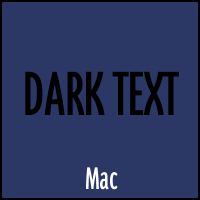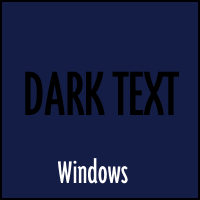Crossing Platforms: Pitfalls and Priorities
March 23, 1999
by Tommy Kiser
So they tell you that you can use Macromedia Director to make cross-platform, multimedia presentations. "Cool," you say, and proceed to hover over your Macintosh for the next few months, learning and creating and not showering, until your Director masterpiece is finally complete. "Ha Ha! Now for the final step...if this tests out okay on the PC, then I will rule the world!" (Haven't we all said that towards the end of a project?) So you copy it to your trusty Mac Zip Disk and the stage is set for world domination, until... Even if you had a utility installed that would allow the PC to read your Mac zip, you would only see that your labour of love would be too dark to read any of the links, would have big, ugly pixel fades instead of the smooth, beautiful ones you carefully selected on your Mac, and would produce errors every time you tried to use an Xtra. That is, of course, only if you have access to a licensed copy of Director for the PC, because without that, you wouldn't be able to create the PC projector to look at the piece at all.
Before you call Macromedia demanding a refund, let's talk about cross-platforming. First of all, in case you haven't gleaned the meaning from the story above, "cross-platforming" refers to the process of making your multimedia presentation (or anything, for that matter) playable on both Macintosh and PC/Windows platforms. "Cross-platform" can actually describe a piece playable across any two or more multiple operating systems but, for the purposes of this article, we will stick to Mac and Windows since I haven't seen Director 7 for Unix on the shelf at CompUSA yet. I will also point out that while Shockwave movies are platform independent, they require their own set of concerns. This article deals only with issues involved with installed-base media, such as CD-ROM's, hard drives and Zip Disks.
The basic concerns for making your Director CD-ROM a cross-platform one can be split up into three groups: Development Issues, File Management Issues, and Media Issues. Most of the Development Issues will merely cause your presentation to look differently on a PC if you made it on a Mac (or vise versa) whereas oversights in the latter two groups will actually prevent your work from functioning properly when delivered on the opposing platform. Let's delve into the heart of these matters so as to avoid any of the aforementioned undesirable effects.
Development Issues
The first cross-platfom concern you have to worry about is color. The gamma on the PC is significantly darker that of the Mac.


This means when you get those black words just how you want them over the dark blue background on the Mac, you will look at them on the PC and have considerable trouble finding them again.
The answer to this problem is a mantra that should be repeated throughout any project's development: test...test...test...test...test. TETO - Test Early, Test Often. If you want your Director presentation to be viewable on a Mac and a PC, you will want to test the living daylights out of it on both platforms. A multimedia piece developed for only one platform necessitates heavy testing, so you can imagine that, in a piece made for two entirely and unpredictably different platforms, the opportunities for bugs are exponentially greater.
Generally, it is a good idea to choose your colors on a PC, or at least simulate PC gamma on your Mac while you are designing. A Mac will only make your PC colors a little lighter - a PC might make your Mac colors too dark to distinguish text or other details. If you have Photoshop installed on your Mac, then you can simply open the control panel called "Gamma", set the target gamma to 2.2 (instead of the Mac's default 1.8), and set the slider called "Gamma Adjustment" to -43. This will adjust your Mac to display at the default PC gamma level. The Gamma Control Panel can be found in the Goodies folder in the Photoshop 5 folder or on the PS 5 CD if you didn't install it with the program. The Yale Web Style Guide is an excellent reference for gamma settings, as well as many other design issues related to the web and general multimedia development.
Another Development Issue is Director's preset transitions. Generally, if you stay away from the "pixel fade" transitions your project should translate easily to Windows. These particular fades (which are some of the best looking on the Mac) are handled very poorly on the PC, and utilize much bigger, bulkier pixel blocks than the Mac version does. This is because the GDI graphics engine that Windows uses to draw to the screen can only access a 4x4 pixel square instead of the Mac which can handle individual pixels. A workable compromise is the pattern dissolve transition. Again, as long as you test thoroughly on both platforms, you will notice any differences in transitions and be able to adjust accordingly.
Fonts also warrant a quick mention. As long as you use the new font-embedding feature of Director 7 (Insert -> Media Element -> Font) fonts will not be a concern. If you are using a previous version of Director, and you use Field cast members in your piece, you'll want to be sure that you choose a font that is standard across both platforms, or code your fields to display in one font for the Mac and a different font for the PC. In order to do this (or any other platform specific coding), you should test "the platform" (projector mode only) or "the machineType" (outdated as of Director 7), and set your fonts or other properties differently based on what result is returned. Here is an example:
if the platform contains "Macintosh" then set the font of member "fieldCastMember" = "Helvetica" else set the font of member "fieldCastMember" = "Arial" end if
Consult Director Help or the Lingo Dictionary for more information on these properties.
Digital Video is another concern when dealing with a cross-platform presentation, but it is an issue which is complicated enough to deserve its own article. In essence, you just want to make sure that the video codec (or format) that you choose is playable on both platforms, and be sure to include installers for both platforms for any outside player application that may be required. Apple's Quicktime format is often used with Director, and is a format playable on both Mac and PC.
A similar issue to video is Audio. There are many different audio formats, and, like video, there are many different issues that will affect which format is the best for your purposes. As far as cross-platforming is concerned you want to make sure that the format you choose is playable on both Mac and PC. The popular PC wave (.wav) format, for example, is not a good choice for cross-platform productions because it is not playable on the Macintosh platform. One of the more common choices is the .aif (or .aiff) format which is the native audio format supported in Director and will playback on both platforms. Any sounds that are imported into Director as castmembers (no matter the original file format) will play back on both platforms, though you need to use bit-depth and sampling rates that will play on PC. For more details on this topic, read the Multimedia Handyman article on cross-platform sound issues.
File Management Issues
The main file management issues with cross-platform CD-ROM's involve Xtras, naming conventions, and projectors. Xtras are external modules, written in a programming language such as C++, that extend the functionality of a Director piece. Unfortunately, Xtras, unlike Director movies, are not cross-platform in and of themselves, so remember when using them to make sure to include both Mac and PC versions of each Xtra that is used. Sometimes this actually involves buying a second license for the other version of the Xtra. You will want to make sure that both copies are resident in a folder called "Xtras" in the root level of your CD-ROM before burning and distributing it.
In regards to naming conventions, it is easy to forget when you work on a Macintosh that PC's require file extensions. In order for a PC to read the files on your CD, they must have standard 3-letter file extensions: .exe for projectors, .dir for unprotected Director files, .dxr for protected ones, .cst or .cxt for Director casts, .mov for Quicktime movies, etc. These simply need to be added to the names of the files for your multimedia piece to be executable on the PC. Also note that if you are burning an ISO 9600 format CD that the format only supports the 8.3 (filename.txt for example as opposed to verylongfilename.txt) naming convention for files on the PC portion of the CD. If you are burning with Adaptec's Toast software, you can avoid this problem by selecting the "Allow Macintosh Names" option in the "Settings" dialog box, and checking the "Use Apple Extensions" box. This will allow long, Mac format names but, as long as you still have three-digit extensions, will be readable by both platforms.
Executables are the subject of the last File Management Issue. Projectors are the actual files that the end user uses to run the Director piece you create. These files are platform-specific, so in order for your CD-ROM to be playable on both platforms, you must create a separate projector for both Macintosh and PC. Unfortunately, you will need PC and Mac copies of Director to create both projectors, so be sure to plan for at least the temporary use of a copy of Director for the opposite platform. Also note that Macintosh 68K and Windows 3.1 machines require projectors specific to their own "sub-platforms. Director 7 does not support these platforms so you will need to create your project in Director 6 if you stil need to provide support for these older machines.
Media Issues
Media issues refers to the actual media you deliver your presentation on. Obviously, the most popular choice for installed-base delivery is CD-ROM. This is very practical, as CD's are not tied to any particular platform, and they are relatively inexpensive to reproduce. Take care when burning a cross platform CD, as you must use the correct file structure (either ISO9660 or a Mac/ISO hybrid format) for the CD to be readable by both platforms.
You may also use some form of removable disk, such as Iomega's Zip or Jaz disks, especially for portfolio pieces, which you may change often. If you do choose a removable disk format, it is a good idea to use a PC-formatted disk, as Mac's can read PC disks, but PC's cannot perform the same feat with Mac disks without a special application. One caveat is that the current Macintosh PC drivers only support 8.3 filenames. If you create a series of files on the Mac and tranfer them to a PC formatted Zip disk the names will be truncated...often in ways that make the filenames unreadable. It can also cause problems when 2 file names get truncated to be the same filename -- one file will overwrite another.
While these are some of the main issues you can come across in developing a cross-platform CD-ROM, never underestimate the value of extensive testing to find any others. Thorough testing is the key to a successful cross-platform presentation. You never know what you are going to find and better you find it than your client. So test until your fingers bleed. Then test a little more. Then test one more time. Then, finally, release your cross-platform CD-ROM.
Copyright 1997-2025, Director Online. Article content copyright by respective authors.